start FIAT CROMA 2006 2.G Owner's Manual
[x] Cancel search | Manufacturer: FIAT, Model Year: 2006, Model line: CROMA, Model: FIAT CROMA 2006 2.GPages: 240, PDF Size: 7.41 MB
Page 88 of 240
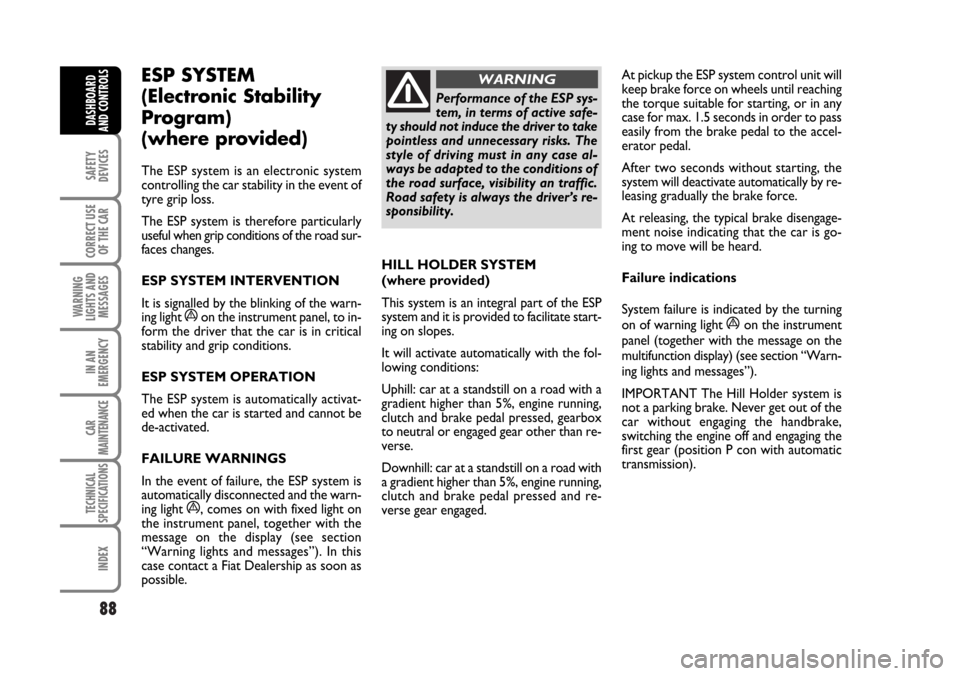
88
SAFETY
DEVICES
CORRECT USE
OF THE CAR
WARNING
LIGHTS AND
MESSAGES
IN AN
EMERGENCY
CAR
MAINTENANCE
TECHNICAL
SPECIFICATIONS
INDEX
DASHBOARD
AND CONTROLS
ESP SYSTEM
(Electronic Stability
Program)
(where provided)
The ESP system is an electronic system
controlling the car stability in the event of
tyre grip loss.
The ESP system is therefore particularly
useful when grip conditions of the road sur-
faces changes.
ESP SYSTEM INTERVENTION
It is signalled by the blinking of the warn-
ing light
áon the instrument panel, to in-
form the driver that the car is in critical
stability and grip conditions.
ESP SYSTEM OPERATION
The ESP system is automatically activat-
ed when the car is started and cannot be
de-activated.
FAILURE WARNINGS
In the event of failure, the ESP system is
automatically disconnected and the warn-
ing light
á, comes on with fixed light on
the instrument panel, together with the
message on the display (see section
“Warning lights and messages”). In this
case contact a Fiat Dealership as soon as
possible.At pickup the ESP system control unit will
keep brake force on wheels until reaching
the torque suitable for starting, or in any
case for max. 1.5 seconds in order to pass
easily from the brake pedal to the accel-
erator pedal.
After two seconds without starting, the
system will deactivate automatically by re-
leasing gradually the brake force.
At releasing, the typical brake disengage-
ment noise indicating that the car is go-
ing to move will be heard.
Failure indications
System failure is indicated by the turning
on of warning light
áon the instrument
panel (together with the message on the
multifunction display) (see section “Warn-
ing lights and messages”).
IMPORTANT The Hill Holder system is
not a parking brake. Never get out of the
car without engaging the handbrake,
switching the engine off and engaging the
first gear (position P con with automatic
transmission).
Performance of the ESP sys-
tem, in terms of active safe-
ty should not induce the driver to take
pointless and unnecessary risks. The
style of driving must in any case al-
ways be adapted to the conditions of
the road surface, visibility an traffic.
Road safety is always the driver’s re-
sponsibility.
WARNING
HILL HOLDER SYSTEM
(where provided)
This system is an integral part of the ESP
system and it is provided to facilitate start-
ing on slopes.
It will activate automatically with the fol-
lowing conditions:
Uphill: car at a standstill on a road with a
gradient higher than 5%, engine running,
clutch and brake pedal pressed, gearbox
to neutral or engaged gear other than re-
verse.
Downhill: car at a standstill on a road with
a gradient higher than 5%, engine running,
clutch and brake pedal pressed and re-
verse gear engaged.
062-098 Croma TRW GB 20-11-2006 15:01 Pagina 88
Page 89 of 240
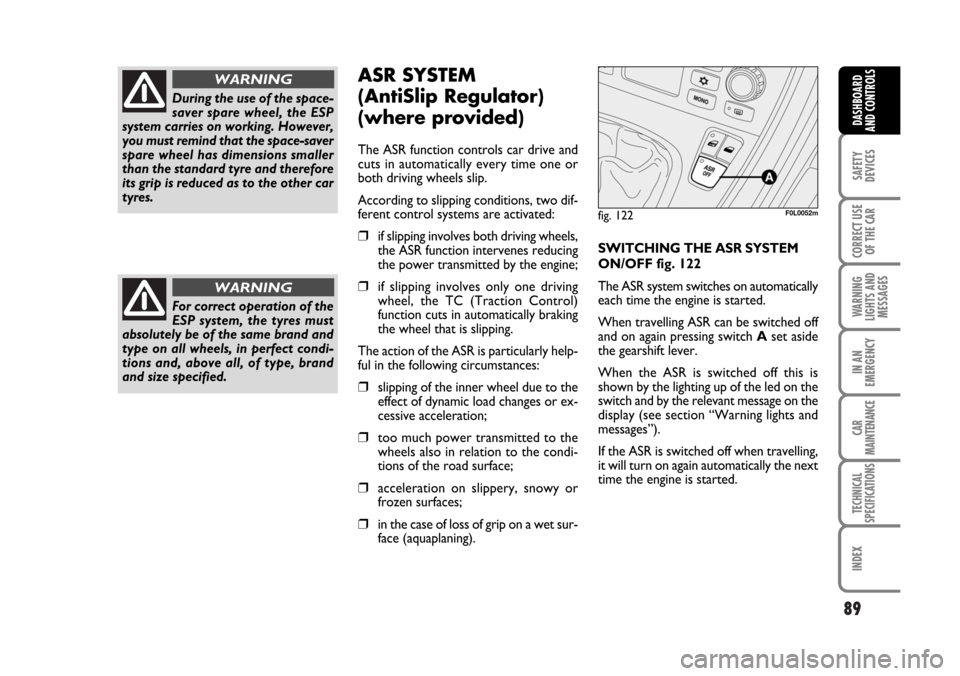
89
SAFETY
DEVICES
CORRECT USE
OF THE CAR
WARNING
LIGHTS AND
MESSAGES
IN AN
EMERGENCY
CAR
MAINTENANCE
TECHNICAL
SPECIFICATIONS
INDEX
DASHBOARD
AND CONTROLS
ASR SYSTEM
(AntiSlip Regulator)
(where provided)
The ASR function controls car drive and
cuts in automatically every time one or
both driving wheels slip.
According to slipping conditions, two dif-
ferent control systems are activated:
❒if slipping involves both driving wheels,
the ASR function intervenes reducing
the power transmitted by the engine;
❒if slipping involves only one driving
wheel, the TC (Traction Control)
function cuts in automatically braking
the wheel that is slipping.
The action of the ASR is particularly help-
ful in the following circumstances:
❒slipping of the inner wheel due to the
effect of dynamic load changes or ex-
cessive acceleration;
❒too much power transmitted to the
wheels also in relation to the condi-
tions of the road surface;
❒acceleration on slippery, snowy or
frozen surfaces;
❒in the case of loss of grip on a wet sur-
face (aquaplaning).
SWITCHING THE ASR SYSTEM
ON/OFF fig. 122
The ASR system switches on automatically
each time the engine is started.
When travelling ASR can be switched off
and on again pressing switchAset aside
the gearshift lever.
When the ASR is switched off this is
shown by the lighting up of the led on the
switch and by the relevant message on the
display (see section “Warning lights and
messages”).
If the ASR is switched off when travelling,
it will turn on again automatically the next
time the engine is started.
During the use of the space-
saver spare wheel, the ESP
system carries on working. However,
you must remind that the space-saver
spare wheel has dimensions smaller
than the standard tyre and therefore
its grip is reduced as to the other car
tyres.
WARNING
For correct operation of the
ESP system, the tyres must
absolutely be of the same brand and
type on all wheels, in perfect condi-
tions and, above all, of type, brand
and size specified.
WARNING
fig. 122F0L0052m
062-098 Croma TRW GB 20-11-2006 15:01 Pagina 89
Page 96 of 240
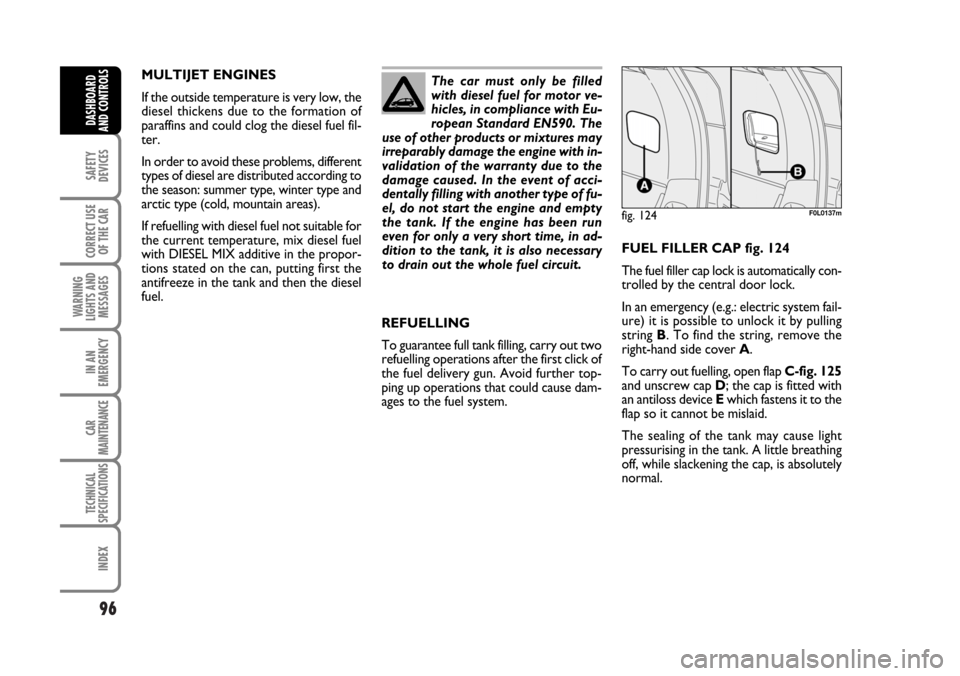
96
SAFETY
DEVICES
CORRECT USE
OF THE CAR
WARNING
LIGHTS AND
MESSAGES
IN AN
EMERGENCY
CAR
MAINTENANCE
TECHNICAL
SPECIFICATIONS
INDEX
DASHBOARD
AND CONTROLS
MULTIJET ENGINES
If the outside temperature is very low, the
diesel thickens due to the formation of
paraffins and could clog the diesel fuel fil-
ter.
In order to avoid these problems, different
types of diesel are distributed according to
the season: summer type, winter type and
arctic type (cold, mountain areas).
If refuelling with diesel fuel not suitable for
the current temperature, mix diesel fuel
with DIESEL MIX additive in the propor-
tions stated on the can, putting first the
antifreeze in the tank and then the diesel
fuel.FUEL FILLER CAP fig. 124
The fuel filler cap lock is automatically con-
trolled by the central door lock.
In an emergency (e.g.: electric system fail-
ure) it is possible to unlock it by pulling
string B. To find the string, remove the
right-hand side cover A.
To carry out fuelling, open flap C-fig. 125
and unscrew cap D; the cap is fitted with
an antiloss device Ewhich fastens it to the
flap so it cannot be mislaid.
The sealing of the tank may cause light
pressurising in the tank. A little breathing
off, while slackening the cap, is absolutely
normal. The car must only be filled
with diesel fuel for motor ve-
hicles, in compliance with Eu-
ropean Standard EN590. The
use of other products or mixtures may
irreparably damage the engine with in-
validation of the warranty due to the
damage caused. In the event of acci-
dentally filling with another type of fu-
el, do not start the engine and empty
the tank. If the engine has been run
even for only a very short time, in ad-
dition to the tank, it is also necessary
to drain out the whole fuel circuit.
fig. 124F0L0137m
REFUELLING
To guarantee full tank filling, carry out two
refuelling operations after the first click of
the fuel delivery gun. Avoid further top-
ping up operations that could cause dam-
ages to the fuel system.
062-098 Croma TRW GB 20-11-2006 15:01 Pagina 96
Page 103 of 240
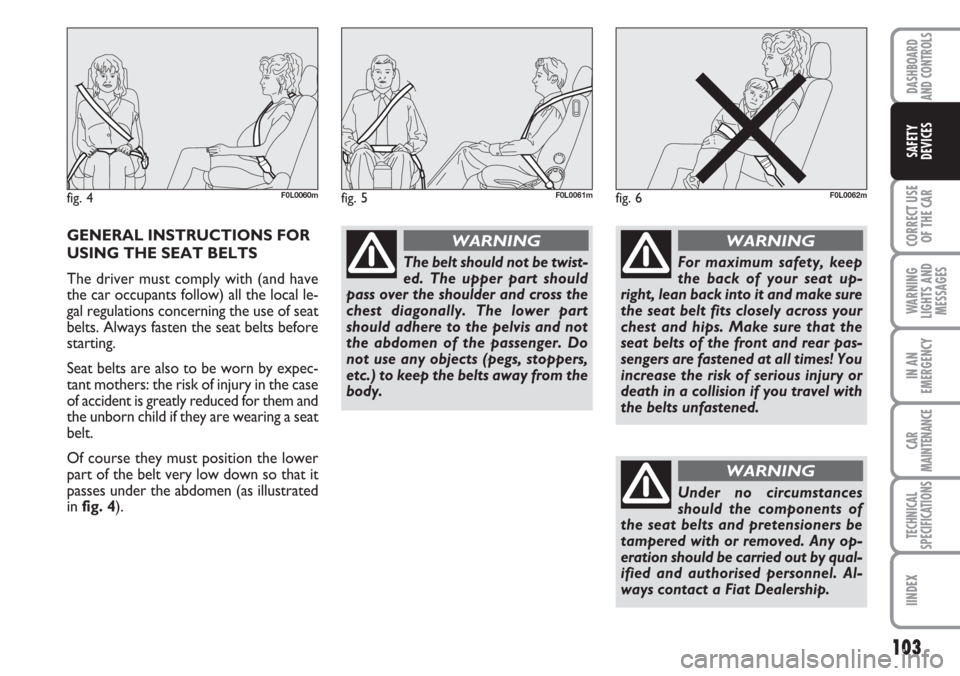
103
CORRECT USE
OF THE CAR
WARNING
LIGHTS AND
MESSAGES
IN AN
EMERGENCY
CAR
MAINTENANCE
TECHNICAL
SPECIFICATIONS
IINDEX
DASHBOARD
AND CONTROLS
SAFETY
DEVICES
GENERAL INSTRUCTIONS FOR
USING THE SEAT BELTS
The driver must comply with (and have
the car occupants follow) all the local le-
gal regulations concerning the use of seat
belts. Always fasten the seat belts before
starting.
Seat belts are also to be worn by expec-
tant mothers: the risk of injury in the case
of accident is greatly reduced for them and
the unborn child if they are wearing a seat
belt.
Of course they must position the lower
part of the belt very low down so that it
passes under the abdomen (as illustrated
in fig. 4).
fig. 4F0L0060mfig. 5F0L0061mfig. 6F0L0062m
The belt should not be twist-
ed. The upper part should
pass over the shoulder and cross the
chest diagonally. The lower part
should adhere to the pelvis and not
the abdomen of the passenger. Do
not use any objects (pegs, stoppers,
etc.) to keep the belts away from the
body.
WARNING
For maximum safety, keep
the back of your seat up-
right, lean back into it and make sure
the seat belt fits closely across your
chest and hips. Make sure that the
seat belts of the front and rear pas-
sengers are fastened at all times! You
increase the risk of serious injury or
death in a collision if you travel with
the belts unfastened.
WARNING
Under no circumstances
should the components of
the seat belts and pretensioners be
tampered with or removed. Any op-
eration should be carried out by qual-
ified and authorised personnel. Al-
ways contact a Fiat Dealership.
WARNING
Page 106 of 240
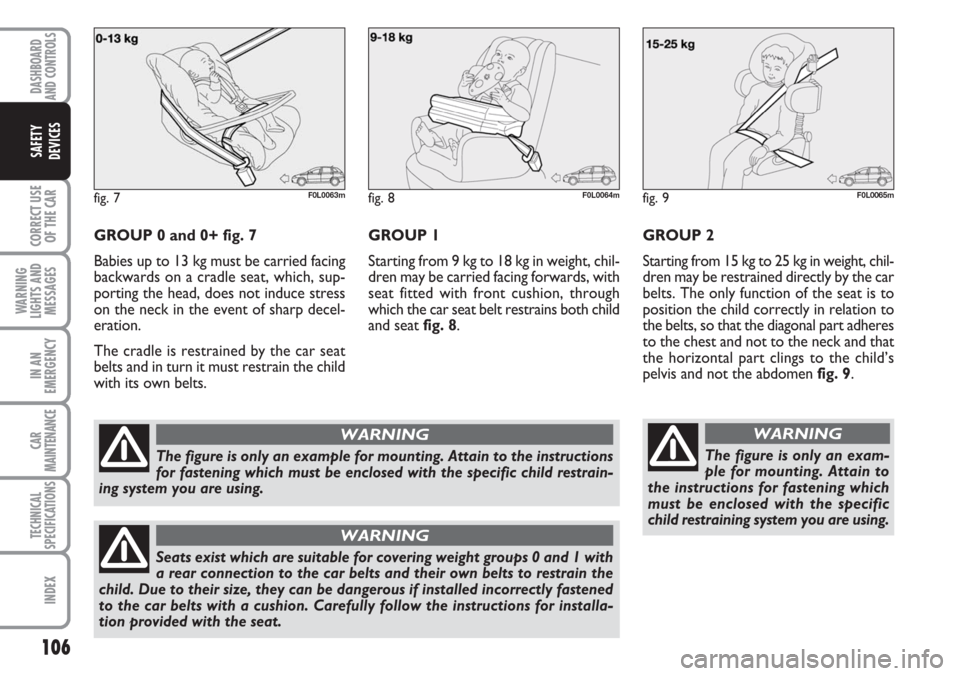
106
CORRECT USE
OF THE CAR
WARNING
LIGHTS AND
MESSAGES
IN AN
EMERGENCY
CAR
MAINTENANCE
TECHNICAL
SPECIFICATIONS
INDEX
DASHBOARD
AND CONTROLS
SAFETY
DEVICES
GROUP 0 and 0+ fig. 7
Babies up to 13 kg must be carried facing
backwards on a cradle seat, which, sup-
porting the head, does not induce stress
on the neck in the event of sharp decel-
eration.
The cradle is restrained by the car seat
belts and in turn it must restrain the child
with its own belts.GROUP 2
Starting from 15 kg to 25 kg in weight, chil-
dren may be restrained directly by the car
belts. The only function of the seat is to
position the child correctly in relation to
the belts, so that the diagonal part adheres
to the chest and not to the neck and that
the horizontal part clings to the child’s
pelvis and not the abdomen fig. 9.
fig. 7F0L0063m
The figure is only an example for mounting. Attain to the instructions
for fastening which must be enclosed with the specific child restrain-
ing system you are using.
WARNING
Seats exist which are suitable for covering weight groups 0 and 1 with
a rear connection to the car belts and their own belts to restrain the
child. Due to their size, they can be dangerous if installed incorrectly fastened
to the car belts with a cushion. Carefully follow the instructions for installa-
tion provided with the seat.
WARNING
fig. 8F0L0064m
GROUP 1
Starting from 9 kg to 18 kg in weight, chil-
dren may be carried facing forwards, with
seat fitted with front cushion, through
which the car seat belt restrains both child
and seat fig. 8.
fig. 9F0L0065m
The figure is only an exam-
ple for mounting. Attain to
the instructions for fastening which
must be enclosed with the specific
child restraining system you are using.
WARNING
Page 118 of 240
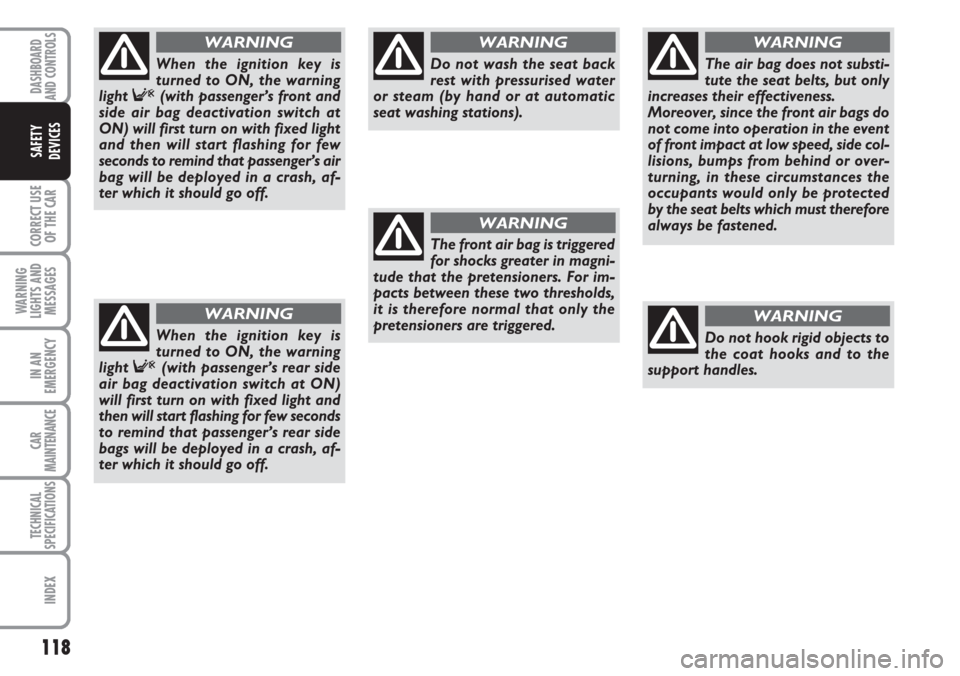
118
CORRECT USE
OF THE CAR
WARNING
LIGHTS AND
MESSAGES
IN AN
EMERGENCY
CAR
MAINTENANCE
TECHNICAL
SPECIFICATIONS
INDEX
DASHBOARD
AND CONTROLS
SAFETY
DEVICES
When the ignition key is
turned to ON, the warning
light
F(with passenger’s rear side
air bag deactivation switch at ON)
will first turn on with fixed light and
then will start flashing for few seconds
to remind that passenger’s rear side
bags will be deployed in a crash, af-
ter which it should go off.
WARNING
Do not wash the seat back
rest with pressurised water
or steam (by hand or at automatic
seat washing stations).
WARNING
The front air bag is triggered
for shocks greater in magni-
tude that the pretensioners. For im-
pacts between these two thresholds,
it is therefore normal that only the
pretensioners are triggered.
WARNING
The air bag does not substi-
tute the seat belts, but only
increases their effectiveness.
Moreover, since the front air bags do
not come into operation in the event
of front impact at low speed, side col-
lisions, bumps from behind or over-
turning, in these circumstances the
occupants would only be protected
by the seat belts which must therefore
always be fastened.
WARNING
Do not hook rigid objects to
the coat hooks and to the
support handles.
WARNING
When the ignition key is
turned to ON, the warning
light
F(with passenger’s front and
side air bag deactivation switch at
ON) will first turn on with fixed light
and then will start flashing for few
seconds to remind that passenger’s air
bag will be deployed in a crash, af-
ter which it should go off.
WARNING
Page 119 of 240
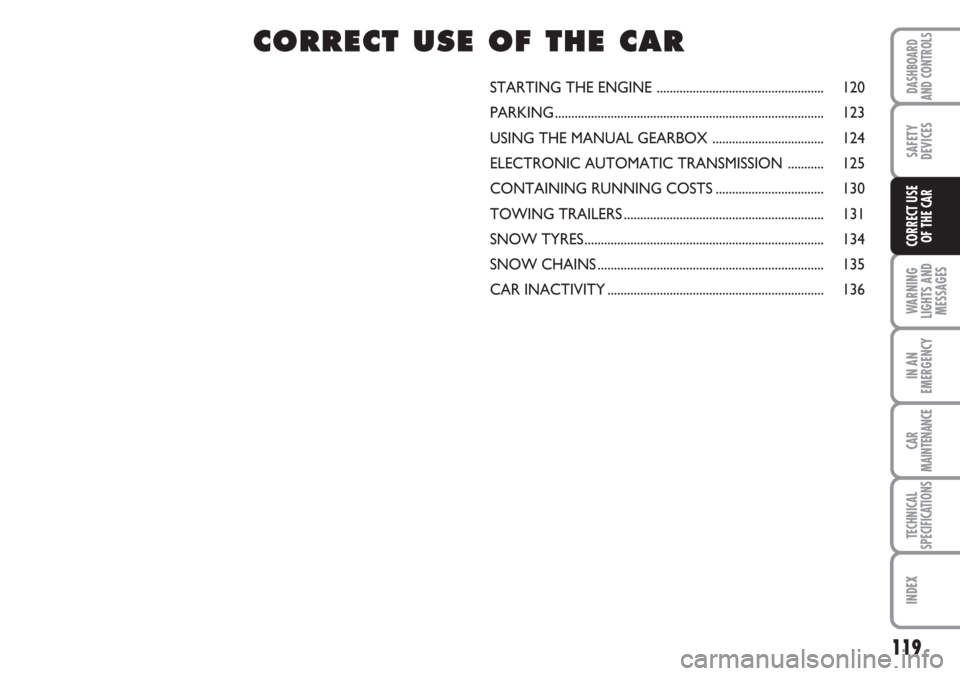
119
WARNING
LIGHTS AND
MESSAGES
IN AN
EMERGENCY
CAR
MAINTENANCE
TECHNICAL
SPECIFICATIONS
INDEX
DASHBOARD
AND CONTROLS
SAFETY
DEVICES
CORRECT USE
OF THE CAR
STARTING THE ENGINE ................................................... 120
PARKING .................................................................................. 123
USING THE MANUAL GEARBOX .................................. 124
ELECTRONIC AUTOMATIC TRANSMISSION ........... 125
CONTAINING RUNNING COSTS ................................. 130
TOWING TRAILERS ............................................................. 131
SNOW TYRES ......................................................................... 134
SNOW CHAINS ..................................................................... 135
CAR INACTIVITY .................................................................. 136
C C
O O
R R
R R
E E
C C
T T
U U
S S
E E
O O
F F
T T
H H
E E
C C
A A
R R
Page 120 of 240
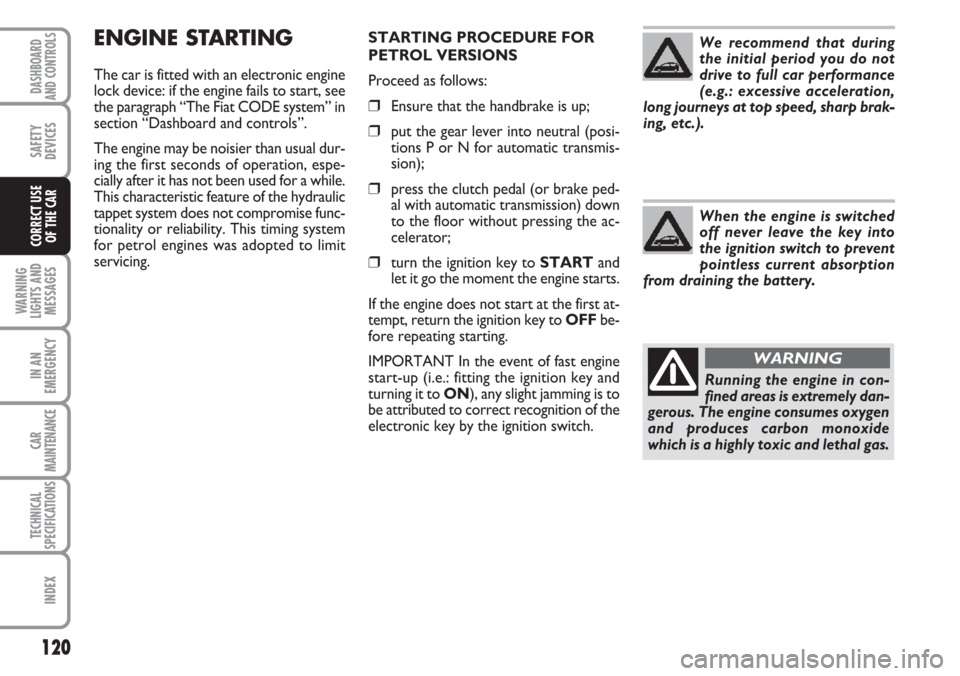
STARTING PROCEDURE FOR
PETROL VERSIONS
Proceed as follows:
❒Ensure that the handbrake is up;
❒put the gear lever into neutral (posi-
tions P or N for automatic transmis-
sion);
❒press the clutch pedal (or brake ped-
al with automatic transmission) down
to the floor without pressing the ac-
celerator;
❒turn the ignition key to STARTand
let it go the moment the engine starts.
If the engine does not start at the first at-
tempt, return the ignition key to OFFbe-
fore repeating starting.
IMPORTANT In the event of fast engine
start-up (i.e.: fitting the ignition key and
turning it to ON), any slight jamming is to
be attributed to correct recognition of the
electronic key by the ignition switch.
ENGINE STARTING
The car is fitted with an electronic engine
lock device: if the engine fails to start, see
the paragraph “The Fiat CODE system” in
section “Dashboard and controls”.
The engine may be noisier than usual dur-
ing the first seconds of operation, espe-
cially after it has not been used for a while.
This characteristic feature of the hydraulic
tappet system does not compromise func-
tionality or reliability. This timing system
for petrol engines was adopted to limit
servicing.
120
WARNING
LIGHTS AND
MESSAGES
IN AN
EMERGENCY
CAR
MAINTENANCE
TECHNICAL
SPECIFICATIONS
INDEX
DASHBOARD
AND CONTROLS
SAFETY
DEVICES
CORRECT USE
OF THE CAR
We recommend that during
the initial period you do not
drive to full car performance
(e.g.: excessive acceleration,
long journeys at top speed, sharp brak-
ing, etc.).
When the engine is switched
off never leave the key into
the ignition switch to prevent
pointless current absorption
from draining the battery.
Running the engine in con-
fined areas is extremely dan-
gerous. The engine consumes oxygen
and produces carbon monoxide
which is a highly toxic and lethal gas.
WARNING
Page 121 of 240
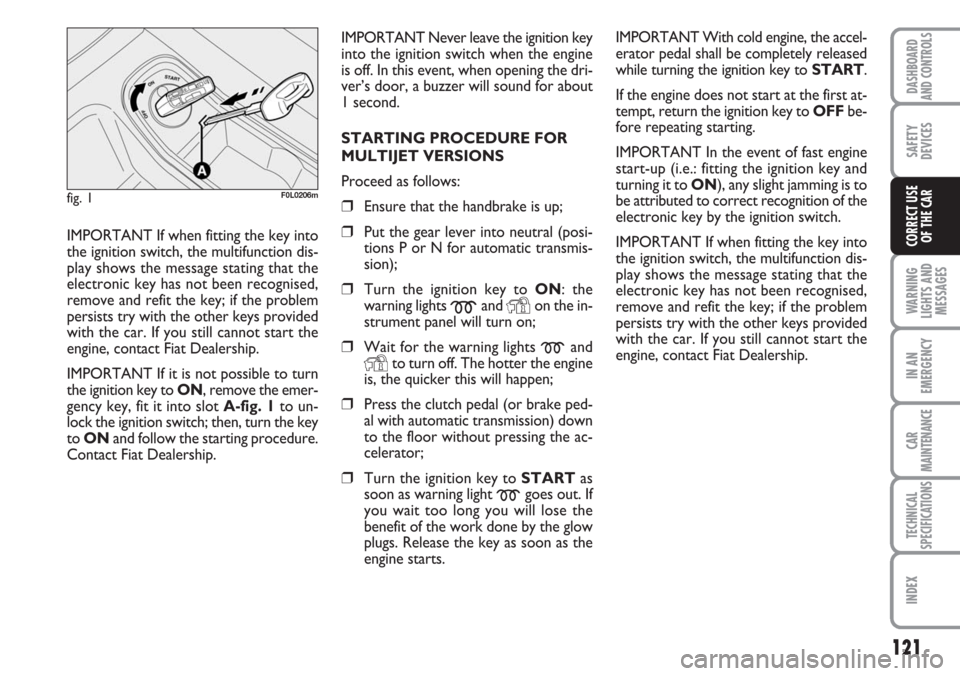
IMPORTANT Never leave the ignition key
into the ignition switch when the engine
is off. In this event, when opening the dri-
ver’s door, a buzzer will sound for about
1 second.
STARTING PROCEDURE FOR
MULTIJET VERSIONS
Proceed as follows:
❒Ensure that the handbrake is up;
❒Put the gear lever into neutral (posi-
tions P or N for automatic transmis-
sion);
❒Turn the ignition key to ON: the
warning lights
mand Yon the in-
strument panel will turn on;
❒Wait for the warning lights mand
Yto turn off. The hotter the engine
is, the quicker this will happen;
❒Press the clutch pedal (or brake ped-
al with automatic transmission) down
to the floor without pressing the ac-
celerator;
❒Turn the ignition key to STARTas
soon as warning light
mgoes out. If
you wait too long you will lose the
benefit of the work done by the glow
plugs. Release the key as soon as the
engine starts.IMPORTANT With cold engine, the accel-
erator pedal shall be completely released
while turning the ignition key to START.
If the engine does not start at the first at-
tempt, return the ignition key to OFFbe-
fore repeating starting.
IMPORTANT In the event of fast engine
start-up (i.e.: fitting the ignition key and
turning it to ON), any slight jamming is to
be attributed to correct recognition of the
electronic key by the ignition switch.
IMPORTANT If when fitting the key into
the ignition switch, the multifunction dis-
play shows the message stating that the
electronic key has not been recognised,
remove and refit the key; if the problem
persists try with the other keys provided
with the car. If you still cannot start the
engine, contact Fiat Dealership. IMPORTANT If when fitting the key into
the ignition switch, the multifunction dis-
play shows the message stating that the
electronic key has not been recognised,
remove and refit the key; if the problem
persists try with the other keys provided
with the car. If you still cannot start the
engine, contact Fiat Dealership.
IMPORTANT If it is not possible to turn
the ignition key to ON, remove the emer-
gency key, fit it into slot A-fig. 1to un-
lock the ignition switch; then, turn the key
to ONand follow the starting procedure.
Contact Fiat Dealership.
121
WARNING
LIGHTS AND
MESSAGES
IN AN
EMERGENCY
CAR
MAINTENANCE
TECHNICAL
SPECIFICATIONS
INDEX
DASHBOARD
AND CONTROLS
SAFETY
DEVICES
CORRECT USE
OF THE CAR
fig. 1F0L0206m
Page 122 of 240
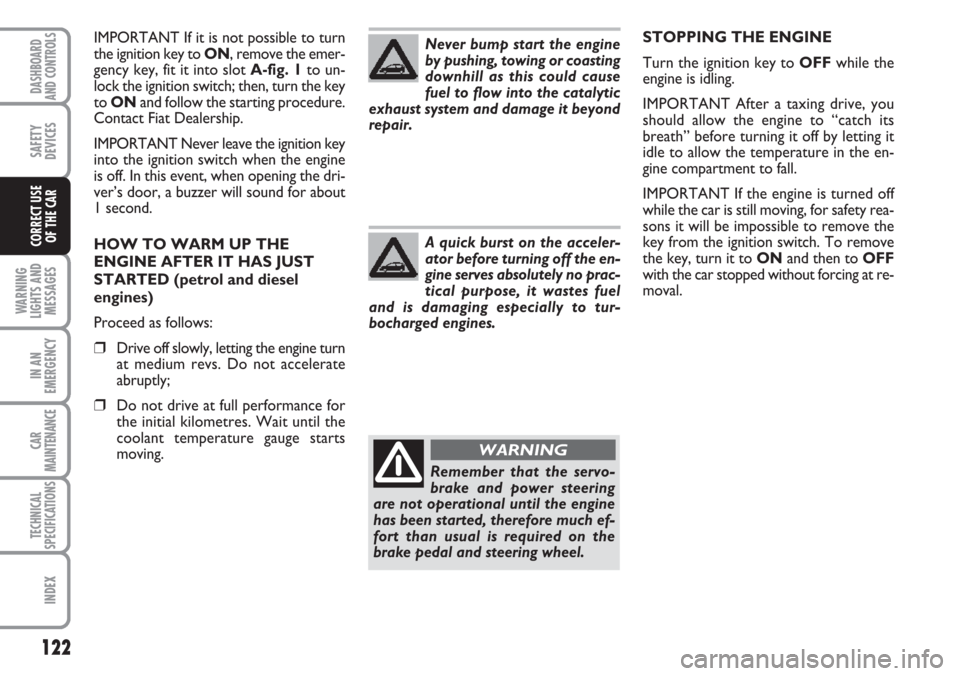
IMPORTANT If it is not possible to turn
the ignition key to ON, remove the emer-
gency key, fit it into slot A-fig. 1to un-
lock the ignition switch; then, turn the key
to ONand follow the starting procedure.
Contact Fiat Dealership.
IMPORTANT Never leave the ignition key
into the ignition switch when the engine
is off. In this event, when opening the dri-
ver’s door, a buzzer will sound for about
1 second.
HOW TO WARM UP THE
ENGINE AFTER IT HAS JUST
STARTED (petrol and diesel
engines)
Proceed as follows:
❒Drive off slowly, letting the engine turn
at medium revs. Do not accelerate
abruptly;
❒Do not drive at full performance for
the initial kilometres. Wait until the
coolant temperature gauge starts
moving.
122
WARNING
LIGHTS AND
MESSAGES
IN AN
EMERGENCY
CAR
MAINTENANCE
TECHNICAL
SPECIFICATIONS
INDEX
DASHBOARD
AND CONTROLS
SAFETY
DEVICES
CORRECT USE
OF THE CAR
Never bump start the engine
by pushing, towing or coasting
downhill as this could cause
fuel to flow into the catalytic
exhaust system and damage it beyond
repair.
A quick burst on the acceler-
ator before turning off the en-
gine serves absolutely no prac-
tical purpose, it wastes fuel
and is damaging especially to tur-
bocharged engines.
Remember that the servo-
brake and power steering
are not operational until the engine
has been started, therefore much ef-
fort than usual is required on the
brake pedal and steering wheel.
WARNING
STOPPING THE ENGINE
Turn the ignition key to OFFwhile the
engine is idling.
IMPORTANT After a taxing drive, you
should allow the engine to “catch its
breath” before turning it off by letting it
idle to allow the temperature in the en-
gine compartment to fall.
IMPORTANT If the engine is turned off
while the car is still moving, for safety rea-
sons it will be impossible to remove the
key from the ignition switch. To remove
the key, turn it to ONand then to OFF
with the car stopped without forcing at re-
moval.